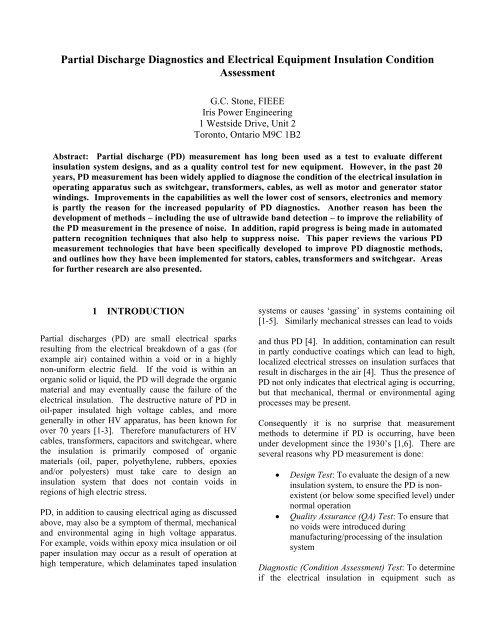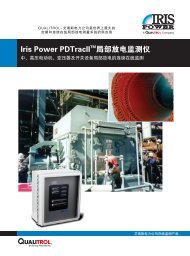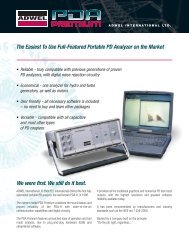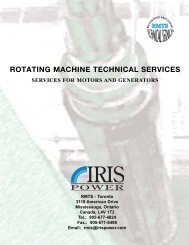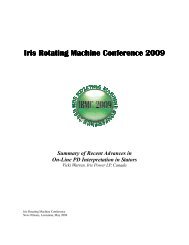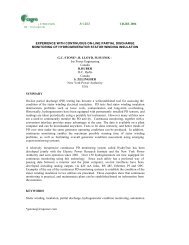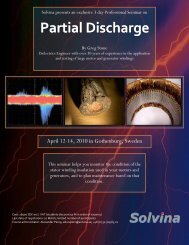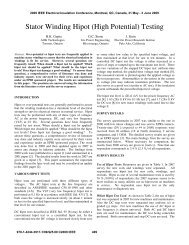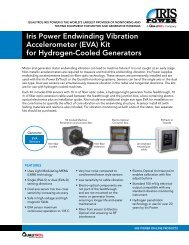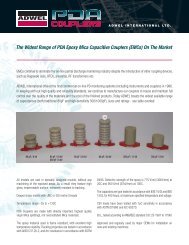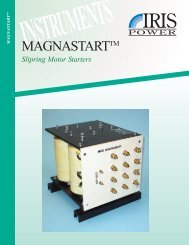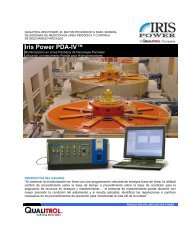Partial Discharge Diagnostics and Electrical Equipment Insulation ...
Partial Discharge Diagnostics and Electrical Equipment Insulation ...
Partial Discharge Diagnostics and Electrical Equipment Insulation ...
Create successful ePaper yourself
Turn your PDF publications into a flip-book with our unique Google optimized e-Paper software.
<strong>Partial</strong> <strong>Discharge</strong> <strong>Diagnostics</strong> <strong>and</strong> <strong>Electrical</strong> <strong>Equipment</strong> <strong>Insulation</strong> ConditionAssessmentG.C. Stone, FIEEEIris Power Engineering1 Westside Drive, Unit 2Toronto, Ontario M9C 1B2Abstract: <strong>Partial</strong> discharge (PD) measurement has long been used as a test to evaluate differentinsulation system designs, <strong>and</strong> as a quality control test for new equipment. However, in the past 20years, PD measurement has been widely applied to diagnose the condition of the electrical insulation inoperating apparatus such as switchgear, transformers, cables, as well as motor <strong>and</strong> generator statorwindings. Improvements in the capabilities as well the lower cost of sensors, electronics <strong>and</strong> memoryis partly the reason for the increased popularity of PD diagnostics. Another reason has been thedevelopment of methods – including the use of ultrawide b<strong>and</strong> detection – to improve the reliability ofthe PD measurement in the presence of noise. In addition, rapid progress is being made in automatedpattern recognition techniques that also help to suppress noise. This paper reviews the various PDmeasurement technologies that have been specifically developed to improve PD diagnostic methods,<strong>and</strong> outlines how they have been implemented for stators, cables, transformers <strong>and</strong> switchgear. Areasfor further research are also presented.1 INTRODUCTION<strong>Partial</strong> discharges (PD) are small electrical sparksresulting from the electrical breakdown of a gas (forexample air) contained within a void or in a highlynon-uniform electric field. If the void is within anorganic solid or liquid, the PD will degrade the organicmaterial <strong>and</strong> may eventually cause the failure of theelectrical insulation. The destructive nature of PD inoil-paper insulated high voltage cables, <strong>and</strong> moregenerally in other HV apparatus, has been known forover 70 years [1-3]. Therefore manufacturers of HVcables, transformers, capacitors <strong>and</strong> switchgear, wherethe insulation is primarily composed of organicmaterials (oil, paper, polyethylene, rubbers, epoxies<strong>and</strong>/or polyesters) must take care to design aninsulation system that does not contain voids inregions of high electric stress.PD, in addition to causing electrical aging as discussedabove, may also be a symptom of thermal, mechanical<strong>and</strong> environmental aging in high voltage apparatus.For example, voids within epoxy mica insulation or oilpaper insulation may occur as a result of operation athigh temperature, which delaminates taped insulationsystems or causes ‘gassing’ in systems containing oil[1-5]. Similarly mechanical stresses can lead to voids<strong>and</strong> thus PD [4]. In addition, contamination can resultin partly conductive coatings which can lead to high,localized electrical stresses on insulation surfaces thatresult in discharges in the air [4]. Thus the presence ofPD not only indicates that electrical aging is occurring,but that mechanical, thermal or environmental agingprocesses may be present.Consequently it is no surprise that measurementmethods to determine if PD is occurring, have beenunder development since the 1930’s [1,6]. There areseveral reasons why PD measurement is done:• Design Test: To evaluate the design of a newinsulation system, to ensure the PD is nonexistent(or below some specified level) undernormal operation• Quality Assurance (QA) Test: To ensure thatno voids were introduced duringmanufacturing/processing of the insulationsystemDiagnostic (Condition Assessment) Test: To determineif the electrical insulation in equipment such as
motors, transformers, switchgear <strong>and</strong> cables has notdeteriorated due to electrical, thermal, mechanical orenvironmental stress during operation.The aim of each of these tests is to ensure that theequipment has the expected service life – that is, theequipment is reliable. If PD is detected, or the PDlevels are too high, it is likely that the insulationsystem will fail prematurely.Although there have been many researchers, thepioneers of practical methods to measure PD duringthe 1950s to 1980s were Bartnikas [6], Kelen [7] <strong>and</strong>Kreuger [8]. These researchers developed the PDdetection methods <strong>and</strong> data display methods that arestill widely used today in laboratories <strong>and</strong> factories.Most of their work was focused on developing testmethods for Design or QA PD testing. Out of theirwork came some basic methods to suppress electricalinterference using differential measurements, as wellas approaches to display PD data using pulsemagnitude analysis <strong>and</strong> phase-resolved pulsemagnitude analysis (also known as pulse phaseanalysis).In the past 20 years, the main focus of research hasbeen to exp<strong>and</strong> PD technology so it can be morepractically applied to diagnostic testing to determinethe condition of the insulation that has seen operation.That is, insulation condition assessment in cables,transformers, switchgear, etc, usually in the plantwhere the apparatus is installed (i.e. on-site).Condition assessment can include both on-line PDtesting, as well as variations of the off-line testing thatis used for Design <strong>and</strong> QA testing. On-site testingrequired developing better <strong>and</strong> better ways ofsuppressing electrical inference (which can lead tofalse indications), as well as developing tools to makethe interpretation of PD pulse phase analysis patternsmore objective. The most prolific researchers for thepast 20 years are perhaps Bartnikas, Boggs, Fruth,Gulski, Hampton, Montanari <strong>and</strong> Okamoto. These <strong>and</strong>other researchers have advanced the science of PDmeasurement technology to the point that off-line <strong>and</strong>on-line PD measurements at site are now routinelyapplied to a high percentage of transformers, cables,machines <strong>and</strong> switchgear that are operating inindustrialized countries. The impact of theseadvancements is the improved reliability of highvoltage equipment since degrading apparatus can berepaired or replaced before catastrophic in-servicefailure occurs. Of course these advances have alsobeen applied to Design <strong>and</strong> QA testing. It is importantto note however, that diagnostic testing cannot give areliable indication of remaining life. Instead thepurpose is to warn of an impending problem, <strong>and</strong>perhaps identify the root cause of the insulationproblem.This paper will first summarize the key features ofmodern PD measurement systems, <strong>and</strong> review some ofthe technology advancements in the past 20 years.The paper then addresses the salient features ofmodern PD methods that have been developed foreach type of electrical apparatus, <strong>and</strong> what questionsremain.2 FEATURES OF PD MEASUREMENTSYSTEMSPD theory <strong>and</strong> a broad overview of PD sensors <strong>and</strong>measurement technology has recently beensummarized by Bartnikas [1]. The followingconcentrates on the sensors, instrumentationtechnology <strong>and</strong> data displays that have, in the past twodecades, become the most popular for equipmentcondition assessment.2.1 SENSORS (COUPLING DEVICES)When a partial discharge pulse occurs, there is a veryfast flow of electrons from one side of the gas filledvoid to the other side. Since the electrons are movingclose to the speed of light across a small distance, thepulse has a very short duration, typically a fewnanoseconds [1]. The electrons carry a charge, thuseach individual discharge creates a current pulse (i =dq/dt). In addition to the electron current flow, therewill be a flow of positive ions (created when theelectrons are ionized from the gas molecules) in theopposite direction. The PD current in the void createsa disturbance <strong>and</strong> results in pulse current <strong>and</strong> voltagethat flows away from the PD site. A Fourier transformof a current pulse indicates that frequencies up toseveral hundred megahertz are created [1].Any sensor (also called a PD coupling device)sensitive to high frequencies can detect the PD pulsecurrents. In an off-line PD test, the most commonmeans of sensing the PD current is to use a high
voltage capacitor connected to the high voltageterminal of the test object (Figure1).coupler, has also been used to detect PD in statorwindings. It works in the 10-1000 MHz range [4].If discharges are occurring on the surface of aninsulation system, then the rapid flow of electrons <strong>and</strong>ions create a gas pressure wave, which can be detectedacoustically. The acoustic pulse created by eachdischarge is concentrated in the 40 kHz (ultrasonic)range [10]. By using directional ultrasonicmicrophones, the location of surface PD on bushings,air-insulated switchgear <strong>and</strong> stator windings can oftenbe identified.Figure 1: Typical off-line PD test arrangement.Typical capacitances are 80 pF to 1000 pF. Thecapacitor is a very high impedance to the high ACvoltage, while being a very low impedance to the highfrequency PD pulse currents. The output of the highvoltage capacitor drives a resistive or inductivecapacitiveload called a ‘detector’ (see Section 2.2).In addition to capacitors, high frequency currenttransformers (HFCTs) can be employed to detect thePD pulse currents. HFCTs typically measure the highfrequency current that may flow in the ground leadfrom a test object. They may also measure the PDpulse currents from the test object to the HV supply.The HFCTs are often wound on split ferrite cores thatcan respond to frequencies in excess of 30 MHz. ForHFCTs applied to HV leads, a large electricalclearance is needed, thus air-core HFCTs (usually aRogowski coil) are used. Rogowski coils areconsiderably less sensitive than ferrite core HFCTs,<strong>and</strong> have a much lower b<strong>and</strong>width due to high interturncapacitance.PD can also be sensed from the following physicalattributes of discharge:• Electromagnetic radiation• Acoustic noise• Visible <strong>and</strong> UV light.Electromagnetic radiation can be detected with RFantennae. The TVA [4] <strong>and</strong> Lemke [9] probes tolocate PD sites are good examples of this. Theantennae are usually tuned to the 5 to 100 MHz range.Another antennae-like device, called the stator slotThe final popular method for sensing PD uses the factthat light is emitted from excited molecules, whichlose their energy after the initial discharge. The mostintense light occurs in the ultraviolet spectrum.Specialized imaging devices have been constructed todetect the UV components of the light [11]. Otherwisethe naked eye can see the light from surface PD, if thetest object is energized with the ambient light levelvery low (black out test).Although many types of PD sensors are now available,HV capacitors are by far the most widely used sensorsfor diagnostic testing. The remainder of this paperwill concentrate on the electrical measurement of thePD pulse currents, rather than on acoustic or UVdetection. In the past 20 years, there has been littleinnovation in current pulse PD sensors.2.2 DETECTORSPD detection normally consists of converting the PDpulse current from the sensor to a voltage signal, sincemost measurement instrumentation is sensitive tovoltage rather than current. The conversion occurs viaa resistor or more elaborate detection impedance. Aresistor yields a wide b<strong>and</strong> detection system with theoutput normally measured in mV or V. However, ifan RLC detection impedance is used, then thecharacteristics of the detector can be manipulated tointegrate (low pass filter) the PD pulse current to yielda signal magnitude that is proportional to the apparentcharge transfer in each discharge [1,6,7]. The RLCdetection impedance is very popular since the rate ofdeterioration of organic insulation is often directlyproportional to the total number of electrons <strong>and</strong> ionsthat bombard the insulation surface. That is, if thedischarges are larger (consists of more electrons <strong>and</strong>ions) the insulation will degrade faster.
IEC 60270 <strong>and</strong> ASTM D1868 outline the types ofdetectors, <strong>and</strong> the RLC detector in particular. Narrowb<strong>and</strong> detectors have a b<strong>and</strong>pass filter/integrator with ab<strong>and</strong>width of about 10 kHz or so, while wideb<strong>and</strong>detectors have a b<strong>and</strong>pass filter/integrator with ab<strong>and</strong>width of 100 to 400 kHz.In the past 20 years there has been a tendency to usesensors <strong>and</strong> detectors with a system b<strong>and</strong>width up toseveral hundred megahertz for equipment such as gasinsulated switchgear (GIS) <strong>and</strong> rotating machines.Such detectors are not covered by ASTM D1868 orIEC 60270. The trend to higher b<strong>and</strong>widths enablesthe use of improved noise suppression <strong>and</strong> facilitatesPD location. However, higher b<strong>and</strong>width (often calledultrawide b<strong>and</strong>) implies that the apparent charge (inpC) may not be directly produced by the detector,since the current is not being directly integrated.2.3 INSTRUMENTATIONElectronic instrumentation is used to measure thesignals from the sensors <strong>and</strong> PD detector combination.Until about 20 years ago, the most popularmeasurement instrument for displaying PD signals wasan analog oscilloscope. The pulses were measured inpC (vertical scale) versus the AC phase position. Dueto the limited oscilloscope b<strong>and</strong>width at the time, itwas often difficult to measure the true magnitude ofthe pulses since they appear only briefly on theoscilloscope screen. In addition, the PD pulserepetition rate was not measurable. For transformer<strong>and</strong> rotating machine PD detection, specialized tunableradio receivers called radio interference voltage (RIV)receivers were also used to display the signals fromcapacitors, HFCTs or antennae.There have been many important developments of themeasuring instrumentation over the past 20 years.Today, virtually all of the instrumentation uses digitaltechnology, rather than analog. The adoption ofdigital technology has lead to developments thatenable noise separation, PD site location <strong>and</strong> practical,continuous on-line PD monitors.2.3.1 DIGITAL INSTRUMENTATIONMeasurement today is usually by digital means. At itssimplest, a digital oscilloscope can be used to measure<strong>and</strong> display the PD. Digital oscilloscopes can veryeasily detect <strong>and</strong> permanently display the magnitudesof the PD pulses. Thus more accurate measurement ofthe peak apparent charge is possible compared toanalog oscilloscopes.However, the most profound change in the past 20years has been the widespread adoption of digitalrecording using pulse magnitude analyzers (PMAs).First introduced to the PD community in the late 1960sby Bartnikas [12], the PMA does not use the typicaloscilloscope display. Instead a digital circuit countsthe number of pulses per second, <strong>and</strong> categorizes thecount rate vs. the magnitude of the pulses (Figure 2).Most modern PMAs separately display the count ratefor positive <strong>and</strong> negative pulses. (It is interesting tonote that Europeans tend to assign the PD polarity bythe polarity of the AC voltage at the time of the pulse,whereas in North America, the polarity of the pulse isthe pulse polarity. The result is that with most of thecommon PD sensor locations, the European <strong>and</strong> NorthAmerican polarity definition is reversed, which maylead to users to assume PD is occurring at (forexample) the HV conductor, rather than near theground. Virtually all commercial PD detectors madein the past decade use the PMA, since the plot isusually very repeatable, <strong>and</strong> gives an indication of thePD repetition rate, while the oscilloscope does not.Figure 2: Pulse magnitude analysis (PMA) plot showing thePulse Count Rate [PPS]10 410 310 210 1Pulse Height Analysis PlotMeas Id: 101, Machine PD + Meas Id: 101, Machine PD -100 200 300 400 500 600 700 800Pulse Magnitude [mV]PD pulse count rate per second per magnitude windowversus the number of pulses per second in the magnitudewindow. Note the different plot for each pulse polarity.Users should be aware if the polarity refers to the detectedpulse polarity, or the polarity of the AC cycle voltage.
Beginning in the early 1970’s, Kelen introduced aprimitive form of what is now called a pulse phaseanalyzer (PPA) also known as a phase-resolved pulsemagnitude analyzer [8]. The PPA is similar to thePMA, with the exception that the phase angle of theAC cycle is also digitally recorded for each PD pulse.The result is a digital representation of the informationthat was originally measured over a complete ACcycle on an oscilloscope. The output of the PPA is atwo or three-dimensional plot of the pulse count ratevs. the pulse magnitude vs. the AC phase position ofthe pulses. There are many ways to display thisoutput. Fruth [13] <strong>and</strong> Fujimoto [14] popularized atwo-dimensional colorized presentation of the PPAdata (Figure 3). Usually the pulse repetition rate isdisplayed via a color code – which unfortunately is notst<strong>and</strong>ardized. Virtually all commercial PDinstrumentation made in the past 10 years produces thePPA plots.Pulse Magnitude [mV]3020100-10-20-30Bipolar Slot Total0 to 3.16 pps 3.16 to 10 pps 10 to 31.6 pps 31.6 to 100 pps100 to 316 pps 316 to 1000 pps > 1000 pps Subset 80 45 90 135 180 225 270 315 360Phase Angle [deg]Figure 3: Pulse phase analysis (PPA) plot of the pulsemagnitude versus AC phase position, with the pulse countrate in pulses per second represented as color.The widespread use of digital instrumentation, whichproduces the PMA <strong>and</strong> PPA plots has reduced the needfor human experts to be present at the PD test. Withthe older analog technology, the expert’s presenceduring the test was needed so the expert coulddetermine peak PD magnitudes from the flickeringtraces <strong>and</strong> determine if noise was present during themeasurement. With digital instrumentation, <strong>and</strong> thepermanent recording that it enabled, the expert couldreview the data transmitted by email to a lab or office.3020100-10-20-30This facilitated a considerable productivityimprovement for PD test experts, which in turnlowered test costs.Most of the commercial PD instrumentation in usetoday uses an analog-to-digital converter withsampling rates of about 20 MHz, corresponding to amaximum analog b<strong>and</strong>width of about 10 MHz. Theseare completely compatible with IEC 60270 narrowb<strong>and</strong> <strong>and</strong> wide b<strong>and</strong> detectors. However, somesuppliers are using digitizers with b<strong>and</strong>widths up to350 MHz to enable ultra wideb<strong>and</strong> PD detection, withthe consequent advantages of noise separation <strong>and</strong> PDsite location [4,14,15].2.3.2 NOISE SEPARATIONAs condition assessment has become an importantaspect of PD testing, the desire of users to do on-site<strong>and</strong> on-line PD testing has increased. Off-line testingrequires a shutdown of the HV equipment, <strong>and</strong> oftenalso requires a substantial HV test transformer toenergize the capacitance of the test object. In contrast,on-line tests are done during normal operation of theHV equipment where the apparatus is exposed torealistic operational stresses, so no shutdown isrequired; <strong>and</strong> an HV test transformer is not required.Unfortunately, there is usually much more electricalinterference to contend with in on-site <strong>and</strong> on-linetesting, since the test object is connected or near to thepower system. <strong>Electrical</strong> interference can come fromcorona on air-insulated transmission <strong>and</strong> distributionlines, power tool operation, arc welding, poorelectrical contacts, electrostatic precipitators, etc., allof which produce sparks/discharges that create currentpulses similar to PD. Separating this noise from testobject PD is important since if the noise is mistaken asPD, a false indication of the insulation deterioration isgiven, reducing the usefulness <strong>and</strong> the credibility ofthe PD test.Experts reviewing the PD patterns in PPA plots canusually separate noise from PD – although theseparation is subjective. Automated patternrecognition (see Section 2.4) may also separate PDfrom noise. However, in the past 20 years somehardware (sensors <strong>and</strong> instrumentation) methods toseparate PD <strong>and</strong> noise have also been implemented toseparate PD from noise.
The most widely applied hardware methods areemployed in on-line rotating machine PD detection.One method measures the risetime or width of thepulse: a fast risetime (
instruments have been developed to make site locationmore reliable <strong>and</strong> easy to do. The instrumentationnormally is customized for a particular type of HVapparatus.Perhaps the most work has been devoted to PD sitelocation in power cables <strong>and</strong> associated joints <strong>and</strong>terminations [1, 17-20]. The tests are usually doneoff-line, using a capacitor or an HFCT) as the sensor.Elaborate techniques based on variable gain amplifiersor auto-correlation are usually used to recover the lowlevel reflected PD signals from the noise. Theaccuracy of the method strongly depends on the lengthof the power cable, <strong>and</strong> the dielectric material. Thelonger the power cable, the more difficult is thedetection of the reflected PD pulse due to theattenuation. In addition, the pulse dispersion is greaterfor longer cables, thus accurate location of the PD sitebecomes problematic since the pulse risetime islonger. Some insulating materials such as oil-paperinsulation have an extremely high attenuation <strong>and</strong>dispersion – making PD detection even a few metersfrom the sensor difficult. In spite of these issues,today there is a vibrant business in cable PD detection<strong>and</strong> location, from a variety of vendors.Specialized PD location instrumentation has also beendeveloped for SF 6 insulated transmission lines <strong>and</strong>switchgear [21,22], although a commercial vendordoes not seem to exist. When compared to PDlocation in cables, GIS is ideal, since attenuation <strong>and</strong>dispersion phenomena are very small. Thus the pulserisetimes are very fast, enabling accurate location. Theinstrumentation typically has a b<strong>and</strong>width ranging upto 1 GHz. Although oscilloscopes can be used, autocorrelationmethods have proven to be successful forlocating the PD.There has been considerable research in the past 20years to locate PD sites in transformer windings <strong>and</strong>rotating machine stator windings [23-25] – however itseems no commercial devices easily used by nonexperts,have been developed. Although time domainreflectometry may work in principle, this technique israrely used due to the extreme attenuation PD pulsesencounter as they propagate through windings.Instead, it has been recognized that there are twomodes of pulse propagation in windings, <strong>and</strong> bymeasuring the relative time of arrival of the ‘fast’ <strong>and</strong>‘slow’ modes at a PD sensor, the relative distance tothe PD site can sometimes been determined. The fastmode is due to the relatively quick propagation of PDpulses through the capacitance between coils, yieldingan almost immediate fast risetime pulse at the PDsensor. The slow mode produces a long risetime, lowfrequency pulse that propagates along the complexinductive-capacitive network of the coils. The fastpulse starts the timing to measure the delay time to thearrival of the slow mode pulse. Unfortunately, beforethis method can be used, the transformer or statorwinding needs extensive testing/calibration wherepulses are injected into different locations <strong>and</strong> thepropagation delays are measured between the fast <strong>and</strong>slow modes. Of course ultrasonic, RF or opticalmethods are also available to locate PD in windings -however the transformer or machine winding must bephysically accessible.Although perhaps it is outside of the scope of thispaper, an interesting method has been developed tolocate PD using a combination of PD pulse currentmeasurement <strong>and</strong> a focused beam of X-rays [26]. Inthis method, first proposed by Mole <strong>and</strong> Parrott, anarrow beam of X-rays is scanned over the surface testobject (for example a large epoxy spacer for GIS),while a conventional or ultrawide b<strong>and</strong> detectormeasures the PD. When the X-ray beam is focused ona void, the PD will increase in activity due to the largenumber of initiatory electrons released, <strong>and</strong> thelocation can be inferred.2.3.4 CONTINUOUS MONITORSContinuous monitoring of PD in HV apparatus willgive the maximum warning time of a developinginsulation problem, allowing insulation systemmaintenance to be planned at the most convenient timefor the user. In addition, continuous monitors willfacilitate alarming to warn of rapidly developingproblems, reduce labor costs to collect the PD data <strong>and</strong>reduce travel costs to the equipment site.With very few exceptions, on-line continuous PDmonitoring was not applied more than 10 years ago.Partly this was due to the lack of effective noiseseparation techniques (clearly noise must beautomatically separated from PD in a continuousmonitor – otherwise a human expert is needed toreview all the data – which is prohibitively timeconsuming <strong>and</strong> expensive). At least for apparatus suchas GIS <strong>and</strong> rotating machines – such noise separationmethods are now available (see Section 2.3.2).
In addition, the hardware <strong>and</strong> memory to store the vastamounts of data collected by a continuous monitor wastoo expensive many years ago. The tremendousreduction in integrated circuit <strong>and</strong> memory costs,together with the huge progress in microprocessors,firmware <strong>and</strong> software to process the PD data has alsotended to make continuous PD monitors more costeffective.The most widely applied PD current continuousmonitors are used on motor <strong>and</strong> generator statorswindings [27, 28], <strong>and</strong> the latest versions have a broadrange of communications capabilities allowing testingof rotating machines from anywhere in the world viathe internet or a modem. Although some continuouson-line PD monitors have been made for transformers,they are based on acoustic detection [29].2.4 PATTERN RECOGNITIONOver 35 years ago, CIGRE published a catalogue oftypical PD patterns that might be displayed on anoscilloscope [30]. It was clear from these patterns thatdifferent locations of PD (for example near the HVconductor or near the ground) produced differentpatterns with respect to the AC phase angle <strong>and</strong> withregard to polarity predominance. This same cataloguealso indicated that corona in air <strong>and</strong> sparking due topoor electrical connections produced a distinctivepattern on the oscilloscope display. Thus theoscillographic display of PD current pulse patternscould be used by experts to:• Differentiate PD from noise• Distinguish the root cause of the PD whenone or more failure mechanisms areoccurring.The modern digital display of the phase-resolved PDpattern now allows experts to analyze the pattern afterthe test is done, <strong>and</strong> back at the office – reducing testcosts. Many papers have been published with typicalPD <strong>and</strong> noise patterns measured with modern PDinstrumentation on various types of HV apparatus,allowing experts to better diagnose the condition of theelectrical insulation [31-33]Today perhaps the most actively researched field inelectrical insulation diagnostics is concerned with thetechniques to automate the pattern recognition process,in an attempt to lessen the need for a human experteither to separate noise from PD, <strong>and</strong>/or determine theroot cause of the measured PD. Unfortunately,although there are hundreds of published papers onthis subject, very little independent corroboration ofthe methods have been published. The users of thepattern recognition methods tend only to be thedevelopers of the method. Bartnikas gives anoverview of most of pattern recognition approaches[1], <strong>and</strong> the following merely itemizes the approachesthat are under active development. Perhaps in a fewyears, this research will yield a practical method thathas been independently verified, <strong>and</strong> which can beused by non-experts on a variety of equipment.Multiple PD Sources: Endwinding PD & Slot PD1.51PD Magnitude [p.u.]0.500 15 30 45 60 75 90 105 120 135 150 165 180 195 210 225 240 255 270 285 300 315 330 345 360-0.5-1-1.5Phase Angle [φ°]Reference AC Voltage S:EW = 1:1 S:EW = 1:0.75 S:EW = 1:0.5 S:EW = 1:0.25 S:EW = 1:0.1Figure 6 Two separate PD mechanisms (slot discharge <strong>and</strong> endwinding discharge in a stator winding)mix to change the shape of the PD pattern, which can be described by different skews <strong>and</strong> kurtosis.
Statistical Analysis: This approach uses theprobabilistic quantities: mean, st<strong>and</strong>ard deviation,skew <strong>and</strong> kurtosis to summarize the shape <strong>and</strong> locationof the positive <strong>and</strong> negative PD pulse patterns withrespect to the AC phase angle. Each type of PDmechanism <strong>and</strong> each type of noise is presumed to havea unique set of mean phase angle, st<strong>and</strong>ard deviation,skew <strong>and</strong> kurtosis (for each polarity). It is perhaps thefirst of the automated pattern recognition methods thatwere researched. The raw data comes from the PPAplot (Figure 3). Okamoto <strong>and</strong> Gulski were earlypioneers of this approach, <strong>and</strong> it is embedded in somemodern commercial PD instrumentation [34,35].Figure 6 shows how the PD pattern changes as theratio of two discharge sources change. The patternshapes are reflected in changes in the mean, skew <strong>and</strong>kurtosis with respect to phase angle. This approachseems to be fairly effective when there is a single rootcause for the PD, however, if there are multiplemechanisms or the PD is mixed with noise, theprobably of an incorrect diagnosis seems to berelatively high, <strong>and</strong> so the analysis must be verified byan expert. A variation of this method is to use themixed-Weibull probability distribution to analyze thepulse magnitude plot (rather than PPA data) [36]. Thepremise is that each failure process or noise sourcewill have its own Weibull distribution (with its ownscale <strong>and</strong> shape parameters). If there are two or moredischarge patterns, goodness-of-fit tests can be used toseparate the two distributions. Aside from thedevelopers, this technique has not been widelyadopted.Neural Networks: A tremendous number ofresearchers have been applying this method(developed to emulate human cognitive processes) topartial discharge pulse current pattern recognition[1,37,38]. Regrettably, to date it seems onlyresearchers are using the method, since there is littlepractical application by HV equipment owners.However, research continues <strong>and</strong> eventually thisapproach may prove to be effective in recognizingdifferent patterns with a low probability of error whilebeing useable by non-researchers <strong>and</strong> needing onlyshort computation times. The raw data (or ‘features’)derived from instrumentation that the neural networksprocess might include pulse shape, time betweensuccessive pulse, phase position, magnitude, <strong>and</strong> pulsepolarity. Alternatively the neural network can processdata that has already been statistically pre-processed.A feature of neural networks is that they must first‘learn’, by processing PD data where one supplies thecause of the PD pattern. After learning, unknown PDpatterns are then processed <strong>and</strong> the software yields themost likely cause (specific failure process or noisesource). With some types of neural networks,‘learning’ may be on-going. In comparison to otherpattern recognition systems, a prodigious amount ofcomputation is needed, <strong>and</strong> there is still considerabledisagreement amongst researchers as to the best neuralnetwork method for PD.Fuzzy Logic: This has been applied as a patternrecognition technique in its own right [39, 40], <strong>and</strong>also as a tool to be used with neural networks or timefrequencyclustering (see below). The occurrence ofPD in a void depends upon a very large number ofvariables, each of which has an element ofr<strong>and</strong>omness. These include void shape, gas pressure,previous discharges (<strong>and</strong> the resulting space charge),<strong>and</strong> the presence of an initiatory electron. Thus whena stream of PD occurs even in a single void, there is alot of possible causes for variation in PD magnitude,repetition rate <strong>and</strong> phase position. When there aremultiple voids, the variations are even morecomplicated. Such a complicated <strong>and</strong> variable processhas been called ‘fuzzy’. Fuzzy logic allows one to usevague or non-specific rules to characterize the PD, forexample big pulses are associated with big voids <strong>and</strong>small pulses are associated with small voids undercomparable void space charge <strong>and</strong> pressure conditions.In fuzzy logic, real data such as pulse magnitudes are‘fuzzified’ by making them variable, <strong>and</strong> then a set ofrules (an inference engine) deduces what the pulses arecaused by. Fuzzy logic was first applied to PDpatterns in the early 1990s, <strong>and</strong> receives someattention from researchers today, although not at thesame level as neural networks. To date, the goal offuzzy logic, as a pattern recognition tool is oftenlimited to defining the size of voids in a test object –rather than the larger (<strong>and</strong> more important) issue ofsorting amongst a variety of completely differentfailure <strong>and</strong> noise processes. Also a large number ofrules have to be devised to implement this approach –<strong>and</strong> the knowledge underlying the rules is oftenunknown for real world insulation systems.Wavelet Transformation: The pattern recognitionapproach that has been receiving increased attention inthe past 5 years is the wavelet transformation [41,42].The main use of the wavelet transformation to date hasbeen to reduce the influence of noise in a PD plus
noise signal. As such, it is a software-basedcomplement or replacement of the hardware-basedapproaches to separate PD from noise (Section 2.3.2).The raw data comes from an oscilloscope-type A/Dconverter that presents a digitized version of the PD<strong>and</strong> noise pulse train to the software fortransformation, processing <strong>and</strong> inverse transformation.The outcome is a PPA plot that has the noisesuppressed. In addition to ‘de-noising’, the wavelettransformation may also be a future tool for locatingthe PD sites in windings (since the PD pulse shapechanges as it propagates along the winding), <strong>and</strong>perhaps to identify the root cause of the PD, sincedifferent insulation deterioration mechanisms mayproduce different pulse shapes. Apparently, thewavelet transformation can be rapidly computed, ascompared to the neural network approach. However,there is still controversy about the optimumapproaches to implementing the wavelettransformation for the different PD processes.Wavelet transformation seems to have promise, butmore research seems to be required before it becomespractically applied.Fractal Analysis: Fractals are a means of describingthe shape of objects, <strong>and</strong> thus can be used to categorizethe different three-dimensional patterns that arecreated by a PPA [43]. With this analysis method,different failure mechanisms will produce identifiableclusters on a plane of fractal dimension vs.‘lacunarity’. In recent years there has been relativelylittle effort devoted to this topic, at least for PD phaseresolvedpulse magnitude analysis.Time vs. Frequency Clustering: This is a relativelyrecent analysis method developed by Montanari <strong>and</strong>his colleagues [44,45]. The basic approach is to havehardware that provides an oscilloscope type of A/Dconversion. A transformation is then performed thatallows a plot of time vs. frequency to be constructed.Different noise <strong>and</strong> PD sources apparently cluster inunique portions of the t vs. F map. Fuzzy logic(similar to that described above) is then used toautomatically identify the clusters. Each PD or noisepulse is tagged as being from one of the clusters, <strong>and</strong>conventional PPA plots can be made only from thepulses associated with a particular cluster, so that PPAplots can be made with the noise sources or other PDfailure processes suppressed. This technique has beenapplied to many practical applications, perhaps withthe greatest success in HV power cables. It also seemsto have some efficacy when applied to on-line PDmeasurements of stator windings.3 APPLICATION OF PD DIAGNOSTICSTO SPECIFIC EQUIPMENTThe following briefly reviews how the sensor,instrumentation <strong>and</strong> pattern recognition technologydiscussed above is applied to each major type of HVequipment.3.1 POWER CABLESOil-paper power cables can experience PD (<strong>and</strong>eventually failure) as a result of oil starvation (due toleaks) <strong>and</strong> overheating. Terminations <strong>and</strong> joints maysuffer from the same issues, in addition to thermalcycling <strong>and</strong> poor manufacturing problems. Diagnostictesting of cables using PD current pulse detectionseems to be mainly applied to the terminations <strong>and</strong>joints, since PD more than several tens of meters fromthe measurement points is largely ineffective due tothe severe attenuation <strong>and</strong> dispersion of PD signalspropagating in oil paper. PD can propagate muchfarther in cross-linked polyethylene <strong>and</strong> EPR powercables. However, since these materials tend to have avery short life (less than days?) in the presence of PD,unless there is continuous monitoring (which to date israrely implemented), PD monitoring of the bulk cableis probably not too useful. In contrast, detectingproblems in terminations <strong>and</strong> joints of XLPE <strong>and</strong> EPRpower cables is considered useful, since the PD tendsto exist for much longer periods of time prior to failurein these accessories.Both off-line <strong>and</strong> on-line diagnostic testing is used onoil paper <strong>and</strong> synthetic power cables. Off-line testingmay be done at rated or elevated voltage, using eitherresonant AC or an oscillating surge [19, 46].Normally off-line tests are done with capacitors orHFCTs installed on sheath grounds or cross-bondingconnections. On-line testing almost always usesHFCTs as the sensor [20]. On-line testing is mostlikely to find termination <strong>and</strong> joint problems. Themain issues tend to be interference <strong>and</strong> PD sitelocation. Usually all the methods discussed in Section2.4 have been applied to noise separation, with thetime-frequency clustering technique having somenotable recent success [47]. The time domainreflectometry technique, <strong>and</strong> its more recent hardwareimplementations, seems to be capable of locating cable
sensors are now installed on many thous<strong>and</strong>s ofmotors <strong>and</strong> generators, <strong>and</strong> data has been collected onthese machines for as long as 20 years, there is nowsome statistical basis for determining when the levelsare ‘too high’. Tables of high PD levels have recentlybeen published [51].In rotating machines, it is common to have hundredsof PD sites that are simultaneously active. Also, therecan be several root causes for the PD occurring at thesame time. If there is a single dominant failureprocess, there are fairly simple procedures for decidingwhat the root cause is [4]. However, with multiplemechanisms occurring, deconvoluting thesemechanisms in the PD pattern can be difficult. Mostof the pattern recognition approaches described inSection 2.4 have been applied with greater or lessersuccess. It is still unclear how well these approacheswill work in the h<strong>and</strong>s on maintenance engineer, ratherthan the developer of the technique.As discussed in Section 2.3.3, experimental methodshave been developed to locate the source of the worstPD in a stator winding. However few are in practicaluse. The reason is unclear, but it may be that the needto precisely locate the PD is not as great in statorwindings, since machine disassembly is required toconfirm any location, <strong>and</strong> usually a quick visualexamination will identify the worst insulationdeterioration sites fairly quickly <strong>and</strong> easily.4 FUTURE DIRECTIONSThe above provided a summary of research intoinsulation condition assessment over the past 20 years,together with opinions on what seems to have worked.To achieve a wider acceptance of PD testing forequipment condition assessment, effort into thefollowing areas may be useful:• A large number of approaches to patternrecognition have been explored.Unfortunately, the specific approachesdeveloped have usually only been evaluatedfor effectiveness by the proposer. To datethere is a relatively low level of credibilityassociated with most pattern recognitiontechniques, since many developers (probablyincluding this author) have sometimes overclaimedeffectiveness. Only independentevaluation can prove effectiveness <strong>and</strong>increase acceptance, <strong>and</strong> effort needs to bedevoted to obtaining this independentvalidation.• For rotating machine applications inparticular, where multiple deteriorationprocesses may be occurring simultaneously,methods need to be developed <strong>and</strong> validatedthat are effective in automatically separatingPD associated with each failure process. Suchseparation is needed to determine whatinsulation repair options should be applied.Although some progress has occurred viapattern recognition, much more refinement<strong>and</strong> independent confirmation is needed.• Noise continues to be a large issue in on-site<strong>and</strong> on-line PD testing, especially with HVtransformers. To move PD testing oftransformers from the domain of the expert tothat of the plant engineer, more effort inhardware- <strong>and</strong> software-based noise separationis needed.• Continuing effort is needed to reduce the costof continuous on-line PD measuring systemsfor all types of apparatus. Since insulationfailures are rare, continuous monitoring willonly be widely applied if it is cheap enough tobe applied to all equipment.• <strong>Equipment</strong> owners, who are mainly nonspecialists,for the most part want to be able todo their own testing <strong>and</strong> interpretation. To dothis, pattern recognition, noise separation <strong>and</strong>results interpretation need to be made assimple <strong>and</strong> reliable as routine vibrationanalysis or insulation resistance testing.• Finally, equipment owners would prefer thetesting provides not pC or mV, but theremaining life of the insulation. As discussedin [52], this is probably not feasible, at leastwith PD alone. But it is still an area forcontinued research.CONCLUSION1. The application of PD technology to diagnosethe condition of the electrical insulation inhigh voltage equipment has growndramatically over the past 20 years. Thetechnology has been widely accepted forrotating machine stator windings, <strong>and</strong> to a
lesser degree, cables, transformers <strong>and</strong>switchgear.2. The consequence has been that insulationproblems are sometimes found beforecatastrophic failure, <strong>and</strong> HV equipmentmaintenance costs are reducing.3. Some of the pressure to introduce PDdiagnostics is because ‘time-based’maintenance – that is regular equipmentshutdowns for inspections – is no longerpopular due to lack of manpower <strong>and</strong> therecognition of its high cost. In addition, PDdiagnostics has also gained favor due to costreductions in testing with the introduction ofnew sensors, cheaper electronics <strong>and</strong> memory,as well as powerful software tools.4. The strongest trend in the past 20 years hasbeen the proliferation of pattern recognitiontools to aid in separating PD frominterference, as well as to identify the rootcause of any PD that is detected. A secondtrend has been the move to ultrawide b<strong>and</strong> PDdetection, since it facilitates interferencesuppression as well as the ability to locate PDsites.5. PD diagnostics are useful because they give awarning to equipment owners that there is aproblem. However, as has been discussed inthe past, PD does not appear to be capable ofproviding a tool to estimate remaininginsulation life.Acknowledgment: The author wishes to express hisgratitude to Dr. Ray Bartnikas for the huge influencehe had both on the author’s research as well as on thefield of PD theory <strong>and</strong> technology. The author alsoapologizes to the many researchers who madeimportant contributions which, due to the lack ofspace, could not be recognized here.REFERENCES[1] R. Bartnikas, “<strong>Partial</strong> <strong>Discharge</strong>s. TheirMechanism, Detection, <strong>and</strong> Measurement”,IEEE Trans DEI, Oct 2002, pp763-808.[2] C.L. Davies, P.L. Hoover, “Ionization Studies inPaper Insulated Cables” AIEE Trans Vol 45,1926, p 141.[3] D.M. Robinson, “Dielectric Phenomena in HVCables”, Chapman <strong>and</strong> Hall, London, 1936.[4] G.C. Stone, E.A. Boulter, I. Culbert <strong>and</strong> H.Dhirani, “<strong>Electrical</strong> <strong>Insulation</strong> for RotatingMachines”, Wiley-IEEE Press, 2004.[5] J.P. Vora, S.L. Foster, “Power Transformers <strong>and</strong>Corona Testing”, IEEE Trans PAS, 1965,pp707-714.[6] R. Bartnikas, E.J. McMahon, Editors,“Engineering Dielectrics Volume 1 – CoronaMeasurement <strong>and</strong> Interpretation”, ASTMPublication STP 669, 1979.[7] F.H. Kreuger, “<strong>Discharge</strong> Detection in HighVoltage <strong>Equipment</strong>”, Butterworth-Heinemann,1989.[8] A. Kelen, “The Functional Testing of HVGenerator Stator <strong>Insulation</strong>”, CIGRE Paper 15-03, Sept 1976.[9] E. Lemke, “Progress in PD Probe MeasuringTechnique”, Paper 72.01, ISH, Dresden, 1991.[10] R. Van Haeren, G.C. Stone, J.Meehan, M.Kurtz, “Preventing Failures in OutdoorDistribution Class Metalclad Switchgear”, IEEETrans PAS, Oct 1985, pp2706-2712.[11] K. Forsyth, US Patent 5,886,344,”CorononaDetector with Narrow B<strong>and</strong> Optical Filter”.[12] R. Bartnikas <strong>and</strong> J. Levi, “A Simple PulseHeight Analyzer for PD Rate Measurements”,IEEE Trans IM, 1969, pp341-345.[13] B. Fruth, J. Fuhr, “PD Pattern Recognition as aTool for Diagnosis <strong>and</strong> Monitoring of Aging”,CIGRE Paper 15/33-12, Sept 1990.[14] G.C. Stone, H.G. Sedding, N. Fujimoto, J.M.Braun, “Practical Implementation of
Ultrawideb<strong>and</strong> PD Detectors”, IEEE Trans EI,Feb 1992, pp70-81.[15] P. Morshuis, “Assessment of DielectricDegradation by Ultrawide B<strong>and</strong> PD Detection”,IEEE Trans DEI, Oct 1995, pp744-760.[16] M. Kurtz, G.C. Stone, “Diagnostic Testing ofGenerator <strong>Insulation</strong>”, Canadian ElectricityAssociation Final Report, Part III, Project RP76-17, Dec 1980.[17] M. Beyer, W. Kamm, H. Borsi <strong>and</strong> K. Feser, “ANew Method for Detection <strong>and</strong> Location ofDistributed PD in HV Cables Under ExternalInterference”, IEEE Trans PAS, 1982, pp 3451-3438.[18] J.P. Steiner, P.H. Reynolds, W.L. Weeks,“Estimating the Location of PD in Cables”,IEEE Trans EI, 1992, pp 44-52[19] M.S. Mashikian, R. Luther, J.C. Juricision,“Evaluation of Field Aged Crosslinked PECables by PD Location”, IEEE Trans PD, 1994,pp 620-628.[20] N.H. Ahmed <strong>and</strong> N.N. Srinivas, “On-line PDDetection in Cables”, IEEE Trans DEI, 1998,pp181-188.[21] S.A. Boggs, “Electromagnetic Techniques forFault <strong>and</strong> PD Location in Gas Insulted Cables<strong>and</strong> Substations”, IEEE Trans PAS, 1982, pp1935-1941.[22] M.D. Judd, O. Farish, B.F. Hampton,“Broadb<strong>and</strong> Couplers for UHF Detection of PDin Gas Insulated Substations”, IEE Proc.Science, Measurement <strong>and</strong> Technology, May1995, pp237-243.[23] R.E. James, B.T. Phung, Q. Su, “Application ofDigital Filtering Techniques to theDetermination of PD Location in Transformers”,IEEE Trans EI, 1986, pp657-668[24] J. Fuhr, M. Haessig, P. Boss, “Detection <strong>and</strong>Location of Internal Defects in the <strong>Insulation</strong> ofPower Transformers”, IEEE Trans EI, Dec 1993,pp 1050-1067.[25] J. Simpson, R.C. Tychsen, Q. Su, T.R.Blackburn, R.E. James, “Evaluation of partialdischarge detection techniques on hydrogeneratorsin the Australian Snowy Mountainsscheme. Tumut 1 case study”, IEEE TransEC, March 1995pp18 – 24.[26] S. Rizzetto, G.C. Stone, S.A. Boggs, “TheInfluence of X-rays on PD in Voids”, IEEEConference ion <strong>Electrical</strong> <strong>Insulation</strong> <strong>and</strong>Dielectric Phenomena Oct 1987, pp 89-94.[27] B.A. Lloyd, S.R. Campbell, G.C. Stone,“Continuous On-Line PD Monitoring ofGenerator Stator Windings”, IEEE Trans EC,Dec 1999, pp 1131-1137.[28] Marsh, T. Laird, M. Hoof, “Real Time AssessedCondition Trending Using Continuous PDMonitoring”, EPRI Conference on UtilityGenerator Predictive Maintenance <strong>and</strong>Refurbishment, New Orleans, Jan 2001.[29] J.W. Harley, Task Force 2 Report, TransformerColloquium, CIGRE Study Committee 12, June1999, Budapest[30] CIGRE Working Group Report, “Recognition of<strong>Discharge</strong>s”, Electra No. 11, 1969.[31] G.C Stone, T.E. Goodeve, H.G. Sedding, W.McDermid, “Unusual PD Pulse PhaseDistributions in Operating Machines”, IEEETrans DEI, Aug 1995, pp 567-577.[32] J. Fuhr, M. Haessig, B. Fruth, T. Kaiser, “PDfingerprintsof some high voltage apparatus”IEEE International Symposium on <strong>Electrical</strong><strong>Insulation</strong>, June 1990, pp129 - 132[33] CIGRE Technical Brochure 226, “KnowledgeRules for PD Diagnosis in Service”, 2003.[34] T. Okamoto, T. Tanaka, “Novel PDMeasurement Computer Aided Systems”, IEEETrans EI, 1986, pp 1015-1021.
[35] E. Gulski, F.H. Kreuger, “Computer AidedRecognition of <strong>Discharge</strong> Patterns”, IEEE TransEII, 1992, pp82-92.[36] M. Cacciari, A. Contin, G.C. Montanari, “Use ofa Mixed Weibull Distribution for theIdentification of PD Phenomena”, IEEE TransDEI, Dec 1995, pp1166-1174.[37] N. Hozumi, T. Okamoto, T. Imajo,“Discrimination Of <strong>Partial</strong> <strong>Discharge</strong> PatternsUsing A Neural Network”, IEEE Trans DEI, Jun1992, pp 550 – 556.[38] M. Salama, R. Bartnikas, “Determination OfNeural-Network Topology For <strong>Partial</strong> <strong>Discharge</strong>Pulse Pattern Recognition”, IEEE Trans onNeural Networks, March 2002, pp 446 – 456.[39] D. Wenzel, H. Borsi, E. Gockenbach, “<strong>Partial</strong><strong>Discharge</strong> Recognition And Localization OnTransformers Via Fuzzy Logic”, IEEEInternational Symposium on <strong>Electrical</strong><strong>Insulation</strong>”, June 1994, pp233 - 236[40] M. Salama, R. Bartnikas, “Fuzzy Logic AppliedTo PD Pattern Classification” IEEE TransDEI, Feb. 2000, pp118 – 123.[41] X. Ma, C. Zhou, I.J. Kemp,” Interpretation OfWavelet Analysis And Its Application In <strong>Partial</strong><strong>Discharge</strong> Detection” IEEE Trans DEI, June2002,pp446 – 457[42] L. Satish, B. Nazneen,” Wavelet-BasedDenoising Of <strong>Partial</strong> <strong>Discharge</strong> Signals BuriedIn Excessive Noise And Interference”, IEEETrans DEI, April 2003, pp 354 – 367.[43] L. Satish, W.S. Zaengl, “Can Fractal FeaturesBe Used For Recognizing 3-D <strong>Partial</strong> <strong>Discharge</strong>Patterns” IEEE Trans DEI, June 1995, pp352 –359[44] A. Cavallini, A. Contin, G.C. Montanari, F.Puletti, “Advanced PD Inference in On-FieldMeasurements, Part I, Noise Rejection”, IEEETrans DEI, April 2003, pp216-224.[45] A. Cavallini, A. Contin, G.C. Montanari, F.Puletti, “Advanced PD Inference in On-FieldMeasurements, Part II: Identification of Defectsin Solid <strong>Insulation</strong> Systems”, IEEE Trans DEI,June 2003, pp528-538.[46] E. Gulski, F. Webster, J. Smit, P. Seitz,“Advanced <strong>Partial</strong> <strong>Discharge</strong> Diagnostic Of MVPower Cable System Using Oscillating WaveTestSystem”IEEE <strong>Electrical</strong> <strong>Insulation</strong> Magazine, March2000, pp 17 - 25[47] A. Cavallini, G.C. Montanari, F. Puletti, S.Franchi Bononi, F. Ombello, J.Butt, "Experience Of Testing Polymeric HVCable Systems By An Innovative<strong>Partial</strong> <strong>Discharge</strong> Measurement Approach",POWERCON 2004, Singapore, Nov2004.[48] M. Haessig, R.Brumlich, J. Fuhr, T.Aschw<strong>and</strong>en, “Assessment of <strong>Insulation</strong>Condition of Large Power Transformers by On-Site <strong>Electrical</strong> Diagnosis Methods”, IEEEInternational Symposium on <strong>Electrical</strong><strong>Insulation</strong>, Anaheim CA, April 2000, pp 368-372.[49] P. Brown, “Nonintrusive <strong>Partial</strong> <strong>Discharge</strong>Measurements On High Voltage Switchgear”,IEE Colloquium on Monitors <strong>and</strong> ConditionAssessment <strong>Equipment</strong>, Digest No. 1996/186,Dec. 1996, pp 10/1 - 10/5[50] S.A. Boggs, “Electromagnetic Techniques forFault <strong>and</strong> <strong>Partial</strong> <strong>Discharge</strong> Location in Gas-Insulated Switchgear”, IEEE Trans PAS, July1982, pp 1935-1941.[51] G.C. Stone, V. Warren, “Effect of Manufacturer,Winding Age <strong>and</strong> <strong>Insulation</strong> Type of StatorWinding PD Levels”, IEEE <strong>Electrical</strong> <strong>Insulation</strong>Magazine, Sept 2004, pp 13-17.[52] C. Laurent, C. Mayoux, “Limitations to PD as aDiagnostic for Deterioration <strong>and</strong> RemainingLife”, IEEE <strong>Electrical</strong> <strong>Insulation</strong> Magazine,March 1992, pp 14-17.


